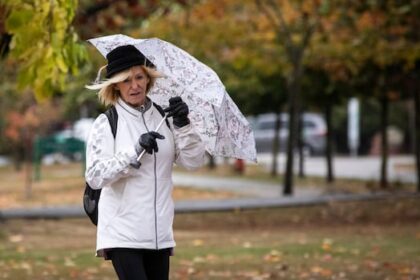This year, Karla Frey had a hard time finishing her usual ofrenda in her Boucherville, Que. home.Two months ago, her five-year-old neighbour and his mother were killed in a car crash. She remembers the little boy visiting her each year, asking questions about her ofrenda — the altar she’s been setting up annually for the past 15 years to honour loved ones who have passed. Weighed down by the thought of a mother dying with her son, Frey powered through and finished setting the altar. She took out her picture frames, candles, a decorative version of a bread known as pan de muerto, papel picado, mezcal, tequila, and cempasúchil (Mexican marigolds), and got to work.”I was thinking about how much my little neighbour loved life. He loved my ofrenda, and I made it a little bit for him, too – and his mom,” confided Frey, looking at the photo of the two neighbours resting at the top of the altar, with a heart hovering over it.This year, that curious five-year-old boy will be visiting her again, but in a different way. “Now, I feel good when I see the finished ofrenda and I see them over there. I’m happy,” said Frey.El Día de Muertos, or Day of the Dead, is a multi-day holiday starting in late October until early November, rooted in Indigenous traditions and celebrated in grand style across Mexico.People honour their late families, friends, children, and pets by reflecting, celebrating and decorating graves, cemeteries, streets and homes. They bring life back through memory, love, and vibrant colours, welcoming the dead.In Quebec, the Mexican diaspora carries these ancestral traditions with them. For Frey, who never celebrated Día de Muertos while living in Mexico City, the holiday isn’t just a way to reconnect with her deceased loved ones, it’s become a bridge between Quebec and her homeland.Dealing with death through memories of lifeEach year, Frey gathers friends in her home and they each share memories of their loved ones. Frey places mezcal, water, and tequila on her altar because, as she explains it, the dead are thirsty when they come to visit. And the scent of copal incense and photographs guide them to the right altar. Remembering the dead is important, she noted, because if you don’t, they die again — this time of sadness. Putting all of her emotions into the ofrendas through the years helped her accept her father’s death more easily. For her, it’s an ”opportunity to exchange.””It’s not just emotion, it’s something visual,” she said. ”I feel that people need to see that the person is gone.”The four elements of nature are represented by different objects: paper for air, candles for fire, salt for earth and water itself. (Hénia Ould-Hammou/CBC)After years of taking part in Day of the Dead festivities, the holiday took on a new meaning for Gerardo Familiar Ferrer after celebrating it with his Indigenous friends in the mountains of Oaxaca — a state in southern Mexico known for its rich Indigenous history. “This moment really changed the way I understand the Day of the Dead, and I have much more respect for the tradition,” said Familiar Ferrer.At his home in Gatineau, Que., Familiar Ferrer’s altar bears a small box with the names of loved ones who’ve passed, including his maternal grandmother. His deep understanding of the traditions has enabled him to share el Día de Muertos with others.The Xoloitzcuintli is a hairless dog and a sacred creature who is believed by the Nahuas to guide the dead through the underworld. (Hénia Ould-Hammou/CBC)For the past week, groups of people eager to discover el Día de Muertos have gathered at UNAM-Canada in Gatineau, where they go on an immersive journey starting in a dimly lit cave.It’s not a real cave, but rather a replica of a setting that is key to understanding the Mexican holiday.”For the Indigenous people of Mexico, caves and caverns are places of contact between the afterlife and the living world,” explained Familiar Ferrer, who works for UNAM-Canada, a language school that organizes the free guided tour.When visitors enter one of the tour’s gravesites, the air is filled with different scents: fir trees, sage, cedars and copal — a smell meant to capture the mood of Mexican cemeteries. The exhibit’s cemetery is shimmering with marigolds, skeletons, flickering candles and Xoloitzcuintle — the dog that accompanies the souls. This tour, which runs until Nov. 8, is one of several examples of Mexican Quebecers sharing their traditions with a wider audience.For Rafael Benitez, a Montrealer who is the interim director and co-founder of PAAL Partageons le monde, organizing the city’s el Día de Muertos festival has also helped him channel his grief to connect with others. When he was five years old, his sister died at birth. And more recently, his mother passed away.”[The festival] helped me greatly in my own grieving process and in understanding my mother’s transition to another stage of life, death, and the cycle,” he said.‘I’m not afraid to die’Though the first edition of the festival was more intimate, over the years, it became a space for intercultural exchange.On Saturday, organizers are holding an event showcasing about 10 themed altars.”I want [people] to remember that, in Montreal, intercultural dialogue is productive and can lead to good things,” Benitez said.Rafael Benitez, left, and his parents. The Day of the Dead has helped him deal with grief and loss, especially the death of his mother and his baby sister. (Submitted by Rafael Benitez)For Benitez, each edition is also an opportunity to recognize the resilience of Indigenous peoples, from the Comcáac in Mexico to the Kanien’kehá:ka to keep ancestral traditions alive. Both peoples will be at the event on Saturday. “I am very grateful because they suffered greatly in the past so that we could present this today,” he said.And people who celebrate the holiday have a message for the uninitiated: despite the notions of death and grief, el Día de Muertos is not meant to be scary.“The second of November is a day for reflection, for thinking about everything these people have done for me, the moments I’ve spent with them,” said Karla Frey, the Boucherville resident, wearing a beaming smile, her energy contagious. “It’s a joyful day, it’s not sad.”For Frey, every year she meticulously curates her ofrenda, is her chance to show her daughters that, when the time comes, she wants them to give her the tribute that she has given to her loved ones.”I want the girls to see how much I love. That way, they’ll know I want to be there,” said Frey.”I’m not afraid to die … I am someone who lives life to the fullest.”
Wednesday, 17 Dec 2025
Canada – The Illusion
Search
Have an existing account?
Sign In
© 2022 Foxiz News Network. Ruby Design Company. All Rights Reserved.
You May also Like
- More News:
- history
- Standing Bear Network
- John Gonzalez
- ᐊᔭᐦᑊ ayahp — It happened
- Creation
- Beneath the Water
- Olympic gold medal
- Jim Thorpe
- type O blood
- the bringer of life
- Raven
- Wás’agi
- NoiseCat
- 'Sugarcane'
- The rivers still sing
- ᑲᓂᐸᐏᐟ ᒪᐢᑿ
- ᐅᑳᐤ okâw — We remember
- ᐊᓂᓈᐯᐃᐧᐣ aninâpêwin — Truth
- This is what it means to be human.
- Nokoma











